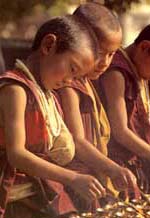Immediately
 after the death of the
Buddha, differences arose among his followers as to the interpretation of the
Master's teachings. After the second council held at Vaishali, two great schools,
the 'Sthaviravadins' (Hinayana) and 'Mahasanghikas' came into being. Hinayana
is also known as Theravada (Doctrine of elders) because it's followers claimed
that their views had the support of the Buddha's immediate followers. According
to them Buddha was the supreme teacher. By the time of Ashoka,
there were eighteen different schools. Ashoka convoked the third council to stem
the tide. In the ultimate, Mahasanghikas paved way for the emergence of 'Mahayana'
(large Vehicle) in the first century AD. The Mahayanists believed that all things were of non-essential
and indefinable in character, and void at bottom. They looked upon Buddha not
merely as a teacher but as a saviour, a Bodhisattva (Essence of Wisdom). The
Mahayanists
emphasis on the Bodhisattva theory, led to the emergence of another school called
'Yogacara'. In this school, not only imaginary beings but exponents or leaders
of various sects were also defined as Bodhisattvas. As a result of inter-mingling
of Buddhistic and Brahmanical speculations the Yogacara school paved way for' Vajrayana' or Tantric Buddhism. Today, there are three major types of
Buddhism;
Theravada, Mahayana and Vajrayana.
after the death of the
Buddha, differences arose among his followers as to the interpretation of the
Master's teachings. After the second council held at Vaishali, two great schools,
the 'Sthaviravadins' (Hinayana) and 'Mahasanghikas' came into being. Hinayana
is also known as Theravada (Doctrine of elders) because it's followers claimed
that their views had the support of the Buddha's immediate followers. According
to them Buddha was the supreme teacher. By the time of Ashoka,
there were eighteen different schools. Ashoka convoked the third council to stem
the tide. In the ultimate, Mahasanghikas paved way for the emergence of 'Mahayana'
(large Vehicle) in the first century AD. The Mahayanists believed that all things were of non-essential
and indefinable in character, and void at bottom. They looked upon Buddha not
merely as a teacher but as a saviour, a Bodhisattva (Essence of Wisdom). The
Mahayanists
emphasis on the Bodhisattva theory, led to the emergence of another school called
'Yogacara'. In this school, not only imaginary beings but exponents or leaders
of various sects were also defined as Bodhisattvas. As a result of inter-mingling
of Buddhistic and Brahmanical speculations the Yogacara school paved way for' Vajrayana' or Tantric Buddhism. Today, there are three major types of
Buddhism;
Theravada, Mahayana and Vajrayana.


 after the death of the
Buddha, differences arose among his followers as to the interpretation of the
Master's teachings. After the second council held at Vaishali, two great schools,
the 'Sthaviravadins' (Hinayana) and 'Mahasanghikas' came into being. Hinayana
is also known as Theravada (Doctrine of elders) because it's followers claimed
that their views had the support of the Buddha's immediate followers. According
to them Buddha was the supreme teacher. By the time of Ashoka,
there were eighteen different schools. Ashoka convoked the third council to stem
the tide. In the ultimate, Mahasanghikas paved way for the emergence of 'Mahayana'
(large Vehicle) in the first century AD. The Mahayanists believed that all things were of non-essential
and indefinable in character, and void at bottom. They looked upon Buddha not
merely as a teacher but as a saviour, a Bodhisattva (Essence of Wisdom). The
Mahayanists
emphasis on the Bodhisattva theory, led to the emergence of another school called
'Yogacara'. In this school, not only imaginary beings but exponents or leaders
of various sects were also defined as Bodhisattvas. As a result of inter-mingling
of Buddhistic and Brahmanical speculations the Yogacara school paved way for' Vajrayana' or Tantric Buddhism. Today, there are three major types of
Buddhism;
Theravada, Mahayana and Vajrayana.
after the death of the
Buddha, differences arose among his followers as to the interpretation of the
Master's teachings. After the second council held at Vaishali, two great schools,
the 'Sthaviravadins' (Hinayana) and 'Mahasanghikas' came into being. Hinayana
is also known as Theravada (Doctrine of elders) because it's followers claimed
that their views had the support of the Buddha's immediate followers. According
to them Buddha was the supreme teacher. By the time of Ashoka,
there were eighteen different schools. Ashoka convoked the third council to stem
the tide. In the ultimate, Mahasanghikas paved way for the emergence of 'Mahayana'
(large Vehicle) in the first century AD. The Mahayanists believed that all things were of non-essential
and indefinable in character, and void at bottom. They looked upon Buddha not
merely as a teacher but as a saviour, a Bodhisattva (Essence of Wisdom). The
Mahayanists
emphasis on the Bodhisattva theory, led to the emergence of another school called
'Yogacara'. In this school, not only imaginary beings but exponents or leaders
of various sects were also defined as Bodhisattvas. As a result of inter-mingling
of Buddhistic and Brahmanical speculations the Yogacara school paved way for' Vajrayana' or Tantric Buddhism. Today, there are three major types of
Buddhism;
Theravada, Mahayana and Vajrayana.